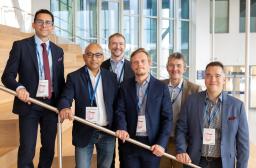The Heart and Lung Center has become a trailblazer of conduction system pacing – “The growth has been phenomenal”
Keywords:According to the attendees of the Nordic Conduction System Pacing Summit organised at HUS at the beginning of June, the Heart and Lung Center is the leader in the field of conduction system pacing in the Nordic countries. In addition to Finland, the summit was attended by participants from Sweden, Norway, Denmark, Estonia and Germany.

The Summit’s keynote speaker and trainer was the renowned Professor Haran Burri from the Geneva University Hospital in Switzerland (second from the left). Other trainers were Amar Taha from Gothenburg, Jarkko Karvonen and Markus Sane from the Heart and Lung Center, Michael Vinther from Copenhagen and Jussi Naukkarinen from the Heart and Lung Center.
In addition to lectures, attendees got to practise implanting conduction system pacemakers using a simulator and watch a live stream of two conduction system pacemaker implantations performed at the Meilahti Tower Hospital.
“The Heart and Lung Center has provided training to both Finnish and foreign learners. We’ve hosted physicians and nurses from many countries who have come here to learn about conduction system pacing”, Deputy Chief Physician and course leader Jarkko Karvonen from the Heart and Lung Center says.
The Summit’s keynote speaker and trainer was the renowned Professor Haran Burri from the Geneva University Hospital in Switzerland. Other trainers were Michael Vinther from Copenhagen, Amar Taha from Gothenburg and Jussi Naukkarinen and Markus Sane from the Heart and Lung Center.
Conduction system pacemakers are implanted nearly every day
Conduction system pacing started at the Heart and Lung Center in 2019 with His bundle pacing, and pacing of the left branch of the conduction system began in 2021 with the visit by Professor Haran Burri. Today, these procedures are carried out almost every day at the hospitals of Meilahti and Jorvi.
“Conduction system pacing is likely to reduce pacing-induced heart failure. The results of small-scale trials have been promising, but the first large-scale randomised trial (PROTECT-HF) has only begun. The Heart and Lung Center is in the process of joining the trial as the only trial site in Finland”, Karvonen says.
The natural way to pace the heart
Professor Haran Burri explains that conduction system pacemakers have been implanted in patients routinely for years. Up to 90% of the implanted cardiac pacemakers are conduction system pacemakers.
“We started with His bundle pacing in 2017, and later on the left branch pacing stater to gain prominence in the field. Even if a patient arrives at our emergency clinic and they have a complete atrioventricular block, we will give them a conduction system pacemaker”, Burri says.
To Burri, conduction system pacing is one of the most interesting and exciting developments in the field of cardiac pacing in the past few years.
“This pacing method changes the well-being of our patients significantly. The pacemaker, which is the size of a small battery, is an engineering marvel! In my view, this is the second major advancement after biventricular pacing, which has also been a success in the field of cardiac pacing”, Burri says.
"The fact that you bring people together is a testament to the success you have achieved in the field of conduction system pacing."
Traditionally, cardiac pacing delivers electrical pulses that slowly travel from one cardiac muscle cell to the next. In some patients, this causes irregular contraction of the heart and may result in heart failure. Conduction system pacing, on the other hand, activates the patient’s own natural conduction system. This causes the heart to contract normally, and the pacing does not impair the pumping of the heart.
”Jarkko Karvonen saw the potential of conduction system pacing very early. Pacemaker treatment has been improved and developed a lot at HUS. The growth has been phenomenal! I don’t think conduction system pacing has grown this well and this fast anywhere else”, Burri says.
“You have a good number of procedures, and your entire team works in an extremely structured and focused manner–that is the secret behind your success! The Nordic countries and, obviously, the Heart and Lung Center are paving the way for the others here. The fact that you bring people together is a testament to the success you have achieved in the field of conduction system pacing”, Burri adds.
Finns are “tech geeks”
Cardiologist Jens Brock Johansen from the Odense University Hospital in Denmark came to attend the training with his junior colleague from the same hospital. He is looking forward to the training provided by HUS due to the hands-on approach.
“Health care systems in different Nordic countries are quite similar. I look forward to being able to take another step forward in the field of conduction system pacing. There’s some excellent cooperation between the Nordic countries in this speciality, and it's great to meet others who work in the same field.”

Conduction system pacing began in Odense in 2023 after training provided by the Heart and Lung Center.
“We take small steps forward, which is why we are here to learn more. So far we have only worked on easier cases. Conduction system pacing is also being studied in Denmark, and once the studies have been completed, we’ll see if conduction system pacing will be added to the national care guidelines.”
“Finns have always been tech geeks who trial new innovations. It’s only natural for an event like this to be held in Finland!”
Johansen sees that it’s important that the training is specifically provided by Finns.
“Finns have always been tech geeks who trial new innovations. It’s only natural for an event like this to be held in Finland!”, Johansen laughs.
Tips for managing challenging cases
Conduction system pacing was introduced at the Nova Heart Hospital in Jyväskylä last year with the leadership of Cardiologist Mari Merentie. For the time being, Merentie is the only cardiologist who implants conduction system pacemakers in Jyväskylä. Merentie implants 2–3 conduction system pacemakers on one day every other week.

Merentie attended the training provided by Jarkko Karvonen in Jyväskylä last autumn. This time, Merentie’s aim is to deepen her skills so that she can teach her colleagues at the Nova Hospital.
“I’ve done a few implantations so far, but I look forward to getting tips for managing challenging cases from others who perform the implantations”, Merentie says.
“At the Nova Heart Hospital, patients are selected for this procedure if they require substantial ventricular pacing and/or if the heart’s contractility is slightly reduced and the there’s no significant enlargement of the right side of the heart”, Merentie explains.
"The staff at HUS want central hospitals, too, to add this procedure to their repertoire."
Merentie says that she has only had positive experiences from working together with the HUS Heart and Lung Center.
“The staff at HUS have readily showed me how a conduction system pacemaker is implanted and how the procedure is carried out. The staff at HUS want central hospitals, too, to add this procedure to their repertoire. I also have a special shout-out to Jarkko for being such an excellent and engaging instructor–a real top talent!”, Merentie says.

Text: Tiina Tuominen
Photos: Mikko Hinkkanen